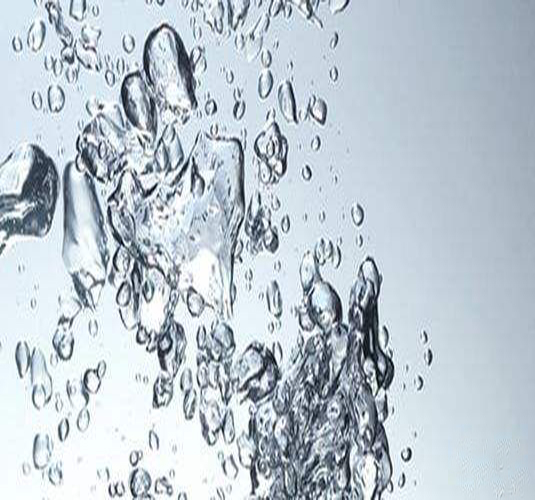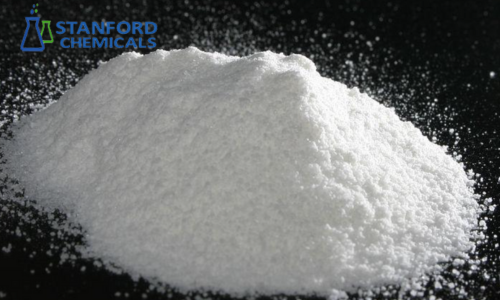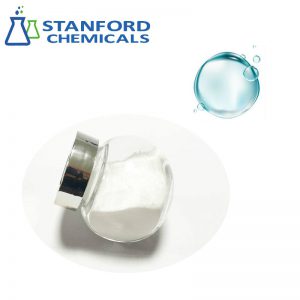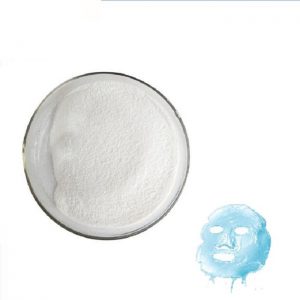- Home
- Hyaluronic Acid
- 020-000-119 Sodium Acetylated Hyaluronate
020-000-119 Sodium Acetylated Hyaluronate
Stanford Chemicals offers a new product-HymagicTM-AcHA, namely Sodium Acetylated Hyaluronate.
| CAS Number | 287390-12-9 |
| Texture | Leaves a silky, non-greasy feel on the skin |
| Benefits for Skin | Water retentio; Barrier support; Diminishing fine lines |
| Uses | Moisturizing, repairing, and anti-aging cosmetic products |
- Description
Description
Sodium Acetylated Hyaluronate Description
Sodium Acetylated Hyaluronate (AcHA), is a specialty HA derivative which is synthesized from the Natural Moisturizing Factor Sodium Hyaluronate (HA) by acetylation reaction. The hydroxyl group of HA is partially replaced with acetyl group. It owns both lipophilic and hydrophilic properties. This helps to promote high affinity and adsorption properties for the skin.
- Recommended Dosage: 0.01%-0.1%
- Usage: Good solubility in water, easy to handle
- Has a fresh and not-sticky feeling.
Sodium Acetylated Hyaluronate Features
- Highly Absorptive on Skin
AcHA exhibits exceptional skin affinity, adhering firmly to the skin even after washing. This ensures prolonged hydration, leaving the skin soft and supple. - Enhanced Moisturizing Power
AcHA assists in delivering double moisturizing capability by the rapid binding with water to enhance levels of hydration of the skin. It maintains the moisturized condition of the skin for over 12 hours, delivering extended hydration. - Supports Skin Barrier Repair and Reduces water evaporation
AcHA accelerates epidermal cell growth and repairs harmed ones, strengthening the skin’s natural barrier function. This reduces internal moisture loss, increases skin elasticity, and eliminates dryness and roughness in comfort.
Sodium Acetylated Hyaluronate Benefits in Skin Care
- Water Retention: Provides long-duration moisture holding of the skin.
- Barrier Support: Strengthens the natural barrier of the skin against environmental stressors.
- Skin Elasticity: Enhances skin smoothness, reducing the appearance of thin wrinkles.
- Soften Effects: Reduces redness and irritation; hence good for sensitive skin.
- Stability Enhanced: More stable and effective over time in skincare formulations.
- Smooth Texture: This leaves a silky, non-greasy feel on the skin.
Synergistic Ingredients with Sodium Acetylated Hyaluronate
| Ingredient(s) | Function / Synergistic Effect |
| Other Small & Large Molecule Hyaluronic Acid | Forms a multi-level moisturizing network (surface, middle, and deep layers of the skin). |
| Glycerin, Panthenol, Amino Acids | Enhances hygroscopicity (moisture attraction) and overall moisturizing efficacy. |
| Ceramides, Cholesterol, Fatty Acids | Work synergistically to repair the skin’s lipid barrier, strengthening its moisture retention and protective functions. |
| Vitamin C, Vitamin E | Its protective film helps stabilize these antioxidants, while the antioxidants in turn protect Hyaluronic Acid from degradation. |
| Peptides, Retinol Derivatives | Creates a “moisturizing base” that can help reduce dryness and discomfort from stimulating actives (e.g., retinol) and may potentially enhance their efficacy. |
(Based on: Formulation science principles and applied research from select manufacturers.)
Sodium Acetylated Hyaluronate vs Sodium Hyaluronate
Sodium Acetylated Hyaluronate is a sodium hyaluronate variant with improved hyaluronic acid properties.
| Feature | Sodium Hyaluronate | Sodium Acetylated Hyaluronate |
| Hydration | Provides effective hydration | Offers longer-lasting hydration |
| Skin Barrier Support | Basic support | Stronger barrier protection |
| Texture | Slightly sticky | Silky and non-greasy |
| Anti-Inflammatory | Minimal | Mild anti-inflammatory properties |
| Stability | Good stability | Higher stability and durability |
Typical Applications of Sodium Acetylated Hyaluronate
Ac HA can be widely applied in repairing, moisturizing, and anti-aging cosmetic products, such as essence, mask, cream, eye cream, etc.
Precautions:
Due to its polyanionic nature, avoid direct mixing with strongly cationic ingredients under extreme pH conditions, as this may cause precipitation or loss of activity. It is recommended to incorporate this ingredient in later stages of formulation and to pay attention to pH adjustment (typically stable within pH 4–8).
The Appearance of Sodium Acetylated Hyaluronate
White to light yellow powder or granules
FAQs
Q: Is sodium acetylated hyaluronate safe for the skin?
A: Yes, it is relatively safe and has low irritation. It should be performed on a patch test on the first use.
Q: What is better, hyaluronic acid or sodium acetylated hyaluronate?
A: Sodium acetylated hyaluronate has a modified molecular structure, enabling it to penetrate deeper into the skin than ordinary hyaluronic acid and deliver longer-lasting hydration.
Q: What are the benefits of sodium hyaluronate eye drops?
A: Effective moisturizing, stimulates repair, minimal irritation, appropriate for dry eyes and eye strain.
Q: What are molecular weights of sodium acetylated hyaluronate?
A: In general between a few thousand and several millions of Daltons, with different molecular weights providing different moisturizing abilities.
Submit your review | |
1 2 3 4 5 | |
Submit Cancel | |
It's pure Hyaluronic Acid. You can't really say anything against it! I ordered this to make some skin serum and quite honestly wasn't sure if it was the "right" molecular weight for a serum. Whatever this is has worked beautifully. You can mix the powder into a little glycerine to emulsify and then add to pure aloe Vera with vitamin c powder and it will gel giving you the best face lift in a bottle for the fraction of the price others sell it for.







